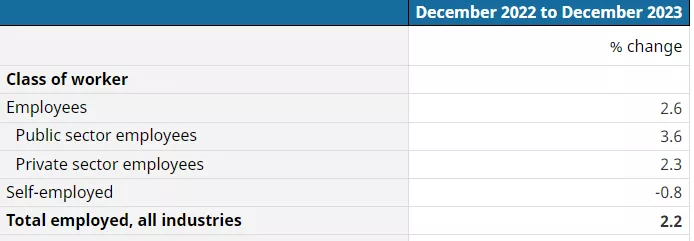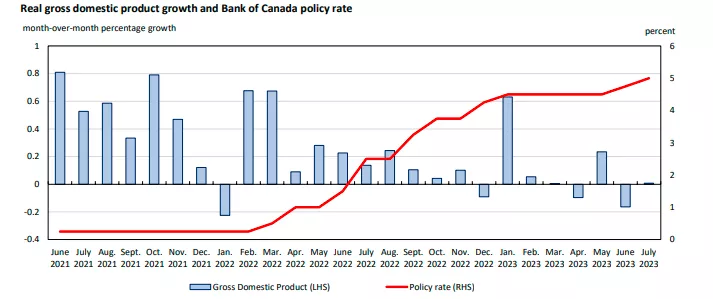 Photo by on
Photo by on
For nearly three years, the Bank of Canada has been in charge of bringing inflation down to its 2% target, even though it would come at the expense of economic growth. The job numbers just released for December confirms that the Bank has ignored the weaknesses in virtually all aspects of the Canadian economy in pursuit of its inflation target. It is time for policy volte face. The Canadian job market is no longer a source of economic growth. Full-time jobs fell 23,500 while part-time jobs climbed by 23,600 in December. Switching from full-time to part-time work is a sure sign of an economy in trouble, as employers are no longer confident that their businesses are doing well enough to take on full-time workers. The Bank of Canada can no longer maintain the economy is working at its potential or that the labour markets are tight and thus pose a threat of re-ignite.Looking back at the year as a whole, employment growth just reflected the increases in the population and in the size of the labour market. Population growth was over 1.1% or 430,000 during the third quarter alone, marking the fastest pace of population growth in any quarter since 1957. This surge in population growth has been underway all through 2023. Yet, it has not translated into significant job growth for the year. Total employed grew by just 2.2%, dominated by the growth in public sector workers.  Source: Statistics CanadaEconomic growth is directly tied to business investment and here Canada’s performance is abysmal. Business investment in plant, machinery and technology will likely rise only by 1.2% in 2023 and a meagre 0.4% in 2024. Nationally, Canadian enterprises point to the combination of a weak consumer and higher borrowing costs as the reasons for holding back on upgrading and expanding capital equipment. In economic parlance, the capital-labour ratio, or physical capital per employee, has declined. In other words, Canada’s competitive position has deteriorated while other nations intensive their capital investment per worker.The correlation between the surge in borrowing costs and the decline in economic activity is unmistakable. As the Bank of Canada raised its policy rate, starting in early 2022, the economy began to stall and now has essentially stalled out totally. The past two quarters’ GDP were negative, below the forecasts of the Bank of Canada upon which policy decisions rested. The Bank has consistently overestimated the economy’s potential growth, to the extent that it is in danger of contributing to a recession with rates at these levels.(Click on image to enlarge)
Source: Statistics CanadaEconomic growth is directly tied to business investment and here Canada’s performance is abysmal. Business investment in plant, machinery and technology will likely rise only by 1.2% in 2023 and a meagre 0.4% in 2024. Nationally, Canadian enterprises point to the combination of a weak consumer and higher borrowing costs as the reasons for holding back on upgrading and expanding capital equipment. In economic parlance, the capital-labour ratio, or physical capital per employee, has declined. In other words, Canada’s competitive position has deteriorated while other nations intensive their capital investment per worker.The correlation between the surge in borrowing costs and the decline in economic activity is unmistakable. As the Bank of Canada raised its policy rate, starting in early 2022, the economy began to stall and now has essentially stalled out totally. The past two quarters’ GDP were negative, below the forecasts of the Bank of Canada upon which policy decisions rested. The Bank has consistently overestimated the economy’s potential growth, to the extent that it is in danger of contributing to a recession with rates at these levels.(Click on image to enlarge) Source: Statistics CanadaSo far, the Bank of Canada continues to talk tough in that there is no hint that rates will start to come down in 2024. Instead, the Bank stands on guard should inflation flare up once again. Many private sector economists dismiss this approach and anticipate rates starting to drop as early as June. However, knowing that there are long lags between the time a rate cut is announced and its actual impact on the economy, waiting to June is simply too little, too late. The weak job numbers and the poor investment outlook are clear signs that rate cuts need to start their decent much early if there is any hope for a favourable reversal of fortunes.More By This Author:
Source: Statistics CanadaSo far, the Bank of Canada continues to talk tough in that there is no hint that rates will start to come down in 2024. Instead, the Bank stands on guard should inflation flare up once again. Many private sector economists dismiss this approach and anticipate rates starting to drop as early as June. However, knowing that there are long lags between the time a rate cut is announced and its actual impact on the economy, waiting to June is simply too little, too late. The weak job numbers and the poor investment outlook are clear signs that rate cuts need to start their decent much early if there is any hope for a favourable reversal of fortunes.More By This Author:
The Bank Of Canada Needs To Change Horses

